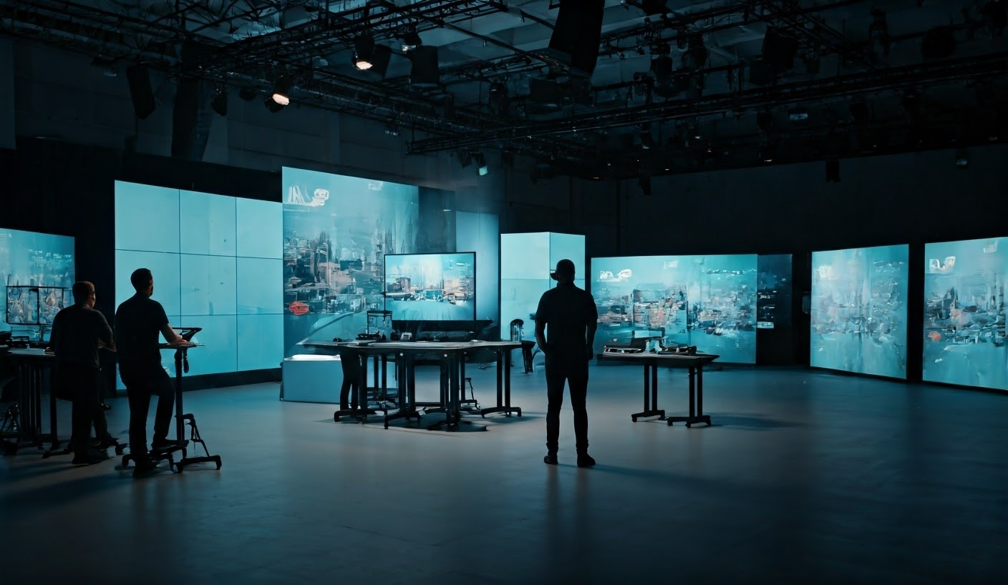The Future of Training Video Production in Melbourne: Trends to Watch

Key Highlights
- Melbourne's training video production landscape is rapidly evolving, driven by technological advancements and changing learner expectations.
- Interactive, immersive, and gamified content is gaining traction, offering engaging and effective learning experiences.
- Artificial intelligence (AI) is transforming video production with a focus on professionalism. It enables personalized content, automates editing processes, and provides data-driven insights to measure learning outcomes.
- Sustainability is paramount. Melbourne video production companies are adopting eco-friendly practices, from green filming techniques to promoting environmental awareness through content.
- Staying ahead of the curve is crucial. Businesses need to embrace these trends to create impactful training videos that meet the demands of the modern workforce.
Introduction
The world of video production and video services in Melbourne, Victoria is always changing. It keeps adapting to new technology and what viewers want. This is especially the case for training video production. Here, the goal is moving from just watching to getting involved. This blog post will look at the new trends that are shaping the future of training video production in Melbourne. It will show how businesses can use these changes to create better learning experiences.
Emerging Trends in Melbourne's Training Video Production
Melbourne is a center for creativity and new ideas. There is a growing need for high-quality training videos. Businesses see the benefits of video for creating engaging and effective learning experiences. So, they are reaching out to video production companies to help make this content.
This need has brought about some interesting trends in training video production. Let’s look at some of the key advancements changing the industry.
The Rise of Interactive and Immersive Video Content
Gone are the days when people just watched videos without getting involved. Today, learners want experiences that actively engage them. Training video production in Melbourne has adapted to this shift, with companies, including our video production team with years of experience, embracing interactive features in their videos.
Interactive video content lets viewers take part in the learning process. Viewers can click on elements, take quizzes, follow different storylines, or even experience virtual reality (VR). By giving learners choices and control, this type of video content makes the learning experience more interesting and helps them remember what they've learned.
This new and fun way of making training videos is changing how information is shared. It makes learning more memorable and impactful for everyone involved.
Leveraging Augmented Reality for Enhanced Learning Experiences
Augmented reality (AR) is now a real part of training video production. It merges computer-made images with the real world, making learning more engaging and interactive.
Think about using your smartphone to point at a machine. A virtual teacher could then walk you through how to use it. Or imagine wearing AR glasses to practice a difficult task in a made-up setting.
Here are some ways AR is used in training videos:
- Virtual Equipment Simulations: AR lets learners work with virtual versions of equipment. This allows them to practice safely without risks.
- Real-time Feedback and Guidance: AR offers immediate help during training. This way, learners can fix errors and improve while they practice.
- Remote Expert Assistance: AR connects trainees with experts far away. These experts can view what trainees see and give advice with virtual notes.
The Integration of Gamification in Training Videos
Gamification is when game features are used in places that are not games. It is becoming a strong tool in training video production. By adding fun elements like points, badges, leaderboards, and challenges, we can turn boring training into an exciting experience.
When learners are interested and involved, they remember information better. Gamified training videos help with this by giving learners a feeling of success and encouraging them to reach their learning goals.
Gamification improves knowledge retention, completion rates, and learner happiness. It benefits both learners and organizations.
The Role of Artificial Intelligence in Training Video Production
Artificial intelligence (AI) is quickly transforming video content. It affects how we create, edit, and share videos. In training video production, AI brings new chances for tailored learning, easier production processes, and insights based on data about how learners engage.
With AI tools for video editing and suggestions for personalized learning, AI will change how we think about, make, and watch training videos.
AI-driven Personalization for Learner Engagement
Personalized learning experiences are important for keeping learners engaged. AI is making it easier to create this in training video production. It looks at learner data like styles, preferences, and progress. With this, AI can suggest content that fits, advise on how fast one should go, and give personalized feedback.
Think about a training video platform that changes the difficulty of content based on how well a learner is doing. Or picture an AI system that finds extra resources and training modules to help with a learner's skill gaps.
This kind of personalization helps learners get the right content when they need it. It makes their learning journey better and enhances the impact of training videos.
Automated Video Editing and Production Processes
AI is making video production easier by automating tasks that used to take a lot of time and effort. AI editing software can now handle things like transcribing, clipping videos, detecting scenes, and even creating simple video edits.
This saves both time and money, letting video producers concentrate more on the creative side of their work. AI tools can look at footage, spot important moments, and suggest fitting music and transitions. This speeds up and improves the editing process.
As AI continues to grow, we can expect even more automation in video production. This will help boost creativity and streamline the entire process.
AI-Powered Analytics for Measuring Learning Effectiveness
Data-driven decisions are important in training and development. AI helps by giving good insights into how engaged learners are and how well training programs work. AI tools can track things like how much of a video was watched, quiz scores, and how learners interact with various activities.
This information shows where learners are doing well or having a hard time. With this, improvements can be made to the training content. Using AI analytics, companies can keep improving their training programs and see how much they benefit from their training efforts.
Collecting and analyzing learner data helps organizations make better and more effective training videos that fit their audience's needs.
Sustainability and Eco-friendly Production Practices
Sustainability is now more than just a trend; it is a duty. The video production industry, which often uses a lot of resources, is adopting green practices. In Melbourne, training video production companies are taking the lead. They are using sustainable methods and sharing messages that raise awareness about the environment in their work.
They focus on energy-efficient lighting and equipment, cutting down on waste, and spreading eco-friendly messages. Sustainability is becoming a key part of video production.
Green Filming Techniques in Melbourne
Green filming techniques minimize the environmental impact of video production. Melbourne-based companies are embracing these practices, transforming how training videos are made:
- Energy Efficiency: Utilizing energy-efficient lighting, equipment, and on-set practices reduces the carbon footprint of productions.
- Sustainable Set Design and Materials: Choosing reusable or recyclable set materials, sourcing props locally, and minimizing waste are key green filming principles.
- Digital Workflows: Shifting towards digital scripts, storyboards, and call sheets minimizes paper consumption.
Here are a few examples of how these practices are implemented:
|
Green Filming Practice |
Description |
|
LED Lighting |
Replacing traditional incandescent lighting with energy-saving LEDs |
|
Reusable Set Pieces |
Utilizing modular and reusable set pieces to reduce waste |
|
Digital Asset Management (DAM) |
Implementing DAM systems for efficient storage and sharing of files |
Promoting Environmental Awareness Through Content
Training video producers are using their platform to raise awareness about the environment. They include eco-friendly themes in their content to educate and inspire viewers about sustainable practices.
This could mean showing what companies are doing for sustainability, stressing the need for environmental care, or teaching eco-friendly work practices. By matching training content with these values, production companies show their dedication to telling responsible stories.
This method educates employees and stakeholders. It also improves a brand’s image by highlighting the company's commitment to corporate social responsibility.
Reducing Carbon Footprint in Video Production Processes
Minimizing the carbon footprint of training video production is very important. Companies are doing what they can to reduce their impact on the environment by:
- Local Production: Keeping travel close for the crew and gear cuts down on carbon emissions.
- Carbon Offsetting: Supporting carbon offsetting programs helps balance out emissions that can't be avoided.
- Sustainable Transportation: Promoting electric cars, public transport, or biking for the crew getting to and from filming spots.
By following these practices, training video production companies can lessen their overall impact on the environment. This helps make the industry more sustainable.
Conclusion
In conclusion, training video production in Melbourne is changing quickly, particularly for staff induction. It is moving towards interactive, engaging, and eco-friendly methods. Using new technologies like augmented reality and gamification is making it easier for learners to connect with the material. Also, using sustainable filming methods and supporting environmental knowledge are important trends in the industry. Businesses can improve by using AI tools to check how effective their training is, and they can tell better stories in their training videos. The future of Melbourne's training video production looks exciting and focuses on new and green practices. This will create strong learning experiences for everyone.
Frequently Asked Questions
How is AI transforming training video production in Melbourne?
AI is changing how training video production works in Melbourne. It helps create personalized learning experiences. AI also automates video editing tasks. Additionally, it gives data-driven insights. This information helps improve content and measure how effective the learning is.
What role does storytelling play in creating engaging training videos?
Storytelling is important for making engaging training videos that incorporate animation and ensure consistency. It helps create an emotional bond with viewers. Stories grab attention and make information easier to relate to. This way, they also help people remember what they learn by putting training content into a memorable story.
How can businesses stay ahead of the curve in utilizing video production for training purposes?
To keep up, businesses need to adopt new trends in video production. This includes adding interactive features, using AI to customize content, and working with production companies that focus on sustainable methods.









